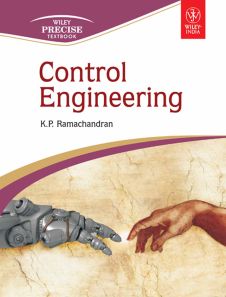Control Engineering
ISBN: 9788126522880
576 pages
Publication Year: 2011
eBook also available for institutional users
For more information write to us at: acadmktg@wiley.com

Description
Control Engineering is the field in which control theory is applied to design systems to produce desirable outputs. It essays the role of an incubator of emerging technologies. It has very broad applications ranging from automobiles, aircrafts to home appliances, process plants, etc. This subject gains importance due to its multidisciplinary nature, and thus establishes itself as a core course among all engineering curricula.
This textbook aims to develop knowledge and understanding of the principles of physical control system modeling, system design and analysis. Though the treatment of the subject is from a mechanical engineering point of view, this book covers the syllabus prescribed by various universities in India for aerospace, automobile, industrial, chemical, electrical and electronics engineering disciplines at undergraduate level.
1 Introduction to Control Systems
Learning Objectives
1.1 Control System Terminology
1.2 Basic Concepts of Control Systems
1.3 Requirements of a Control System
1.4 Types of Control System
Summary
Key Terms
Objective-Type Questions
Review Questions
Answers
2 Mathematical Models
Learning Objectives
2.1 Block Diagrams
2.2 Laplace Transforms
2.3 Transfer Function
2.4 Mechanical Systems
2.5 Electrical Systems
2.6 Electromechanical Systems
2.7 Stepper Motor
2.8 Analogous Circuit Systems
2.9 Thermal and Fluid Systems
2.10 Hydraulic Power System
2.11 Pneumatic System
2.12 Comparison of Hydraulic and Pneumatic Systems
Key Terms
Summary
Objective-Type Questions
Review Questions
Numerical Problems
Answers
3 Block Diagrams and Signal Flow Graphs
Learning Objectives
3.1 Block Diagram of a Closed-Loop System
3.2 Block Diagram Simplification
3.3 Signal Flow Graphs
Summary
Key Terms
Objective-Type Questions
Review Questions
Numerical Problems
Answers
4 Transient and Steady-State Response Analysis
Learning Objectives
4.1 Test Signal
4.2 Static Response
4.3 Poles, Zeros and Stability
4.4 Transient Response
Summary
Key Terms
Objective-Type Questions
Review Questions
Numerical Problems
Answers
5 Frequency Response Analysis using Nyquist Diagrams
Learning Objectives
5.1 Frequency Response Analysis
5.2 Polar Plots
5.3 Stability Analysis using Nyquist Diagrams
5.4 Relative Stability, Gain Margin and Phase Margin
5.5 Frequency Domain Specification
5.6 M & N Circles
5.7 Nichols Chart
Summary
Key Terms
Objective-Type Questions
Review Questions
Numerical Problems
Answers
6 Frequency Response Analysis using Bode Diagrams
Learning Objectives
6.1 Bode Diagrams
6.2 Calculation of Transfer Function from Bode Plots
Summary
Key Terms
Objective Type Questions
Review Questions
Numerical Problems
Answers
7 Root Locus Plots
Learning Objectives
7.1 Definition
7.2 Sketching Root Loci
7.3 Refining the Sketch
7.4 Effect of Adding Open-Loop Poles and Open-Loop Zeros
7.5 Advantages of Root Locus
7.6 Some Definitions
Summary
Key Terms
Objective-Type Questions
Review Questions
Numerical Problems
Answers
8 Control Action and System Compensation
Learning Objectives
8.1 Compensation
8.2 Types of Compensation
8.3 Compensating Networks
8.4 Design of Compensators
Summary
Key Terms
Objective-Type Questions
Review Questions
Numerical Problems
Answers
9 Controllers
Learning Objectives
9.1 Controller Principles
9.2 Two-Position Controller (ON/OFF Controller)
9.3 Proportional Controllers
9.4 Integral Controller
9.5 Derivative Controller
9.6 Composite Controller Modes
9.7 Selection of Controllers
9.8 PID Controller Tuning
9.9 Digital Controllers
9.10 Adaptive Controllers
Summary
Key Terms
Objective-Type Questions
Review Questions
Numerical Problems
Answers
10 State Variable Models
Learning Objectives
10.1 State Variables of Dynamic System
10.2 State Differential Equation using Physical Variables
10.3 Converting a Transfer Function into State Space using Phase Variables
10.4 Signal Flow Graph State Models
10.5 State Space Representation using Canonical Variables
10.6 Transfer Function from the State Equation
10.7 Eigen Values and Eigen Vectors
10.8 State Transition Matrix and Time Response
10.9 Controllability and Observability
Summary
Key Terms
Objective-Type Questions
Review Questions
Numerical Problems
Answers
Appendix A Introduction to MATLAB Programming
· A.1 Application of MATLAB Programs for Control Problems
· A.2 Summary of Commands
Appendix B Basics of Matrices
· B.1 Definition of Matrices
· B.2 Addition and Subtraction of Matrices
· B.3 Multiplication of Matrices
· B.4 Determinants
· B.5 Transpose of Matrix
· B.6 Adjoint (or Adjugate) of Matrix
· B.7 Inverse of Matrix
Model Question Paper 1
Model Question Paper 2
Model Question Paper 3
Bibliography
Index

